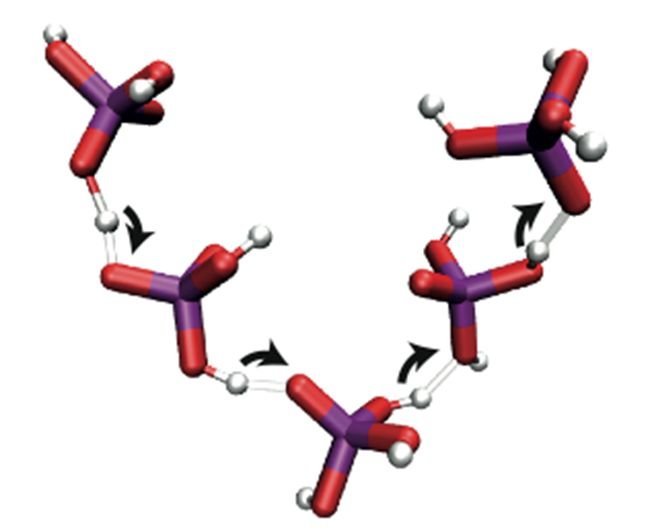Revealing the Mechanisms of Proton Conduction in Phosphorous Acid based Systems: A Unique Class of Proton Conductors
 The concept of “hydrogen bond network frustration” (imbalance of number of proton donors and acceptors) provides a useful concept for explaining the very high intrinsic proton conductivity of phosphoric acid (and related systems).
The concept of “hydrogen bond network frustration” (imbalance of number of proton donors and acceptors) provides a useful concept for explaining the very high intrinsic proton conductivity of phosphoric acid (and related systems).
K. D. Kreuer, G. Lentz, N. Hainovsky, J. Maier, and H. Küppers
Saure Sulphate, Selenate und Phosphate: Protonenleitung und Struktur
Berichte der Deutschen Mineralogischen Gesellschaft, Beitrag zum European Journal of Mineralogy 4(1), 162–162 (1992).
Th. Dippel, K. D. Kreuer, J. C. Lassègues, and D. Rodriguez
Proton conductivity in fused phosphoric acid; A 1H/31P PFG-NMR and QNS study
Solid State Ionics 61(1–3), 41–46 (1993).
DOI: 10.1016/0167-2738(93)90332-W
K.-D. Kreuer
Proton Conductivity: Materials and Applications
Chemistry of Materials 8(3), 610–641 (1996).
DOI: 10.1021/cm950192a
G. Harley, K.-D. Kreuer, J. Maier, and L. C. De Jonghe
Structural investigation of ternary La/alkaline earth phosphate (La(1-x)MxP3Oy) (M=Ba, Ca, Sr) glasses
Journal of Non-Crystalline Solids 355(16-17), 932–937 (2009).
DOI: 10.1016/j.jnoncrysol.2009.04.023
L. Vilciauskas and K.-D. Kreuer
Comment on “Mixed Grotthuss and Vehicle Transport Mechanism in Proton Conducting Polymers from Ab initio Molecular Dynamics Simulations”
Chemistry of Materials 23(14), 3377–3378 (2011).
DOI: 10.1021/cm200865v
L. Vilciauskas, C. C. de Araujo, and K.-D. Kreuer
Proton conductivity and diffusion in molten phosphinic acid (H3PO2): The last member of the phosphorus oxoacid proton conductor family
Solid State Ionics 212, 6–9 (2012).
DOI: 10.1016/j.ssi.2012.02.019
L. Vilciauskas, M. E. Tuckerman, G. Bester, S. J. Paddison, and K.-D. Kreuer
The mechanism of proton conduction in phosphoric acid
Nature Chemistry 4(6), 461–466 (2012).
DOI: doi:10.1038/nchem.1329
L. Vilciauskas, M. E. Tuckerman, J. P. Melchior, G. Bester, and K.-D. Kreuer
First principles molecular dynamics study of proton dynamics and transport in phosphoric acid/Imidazolemidazole (2:1) system
Solid State Ionics 252, 34–39 (2013).
DOI: 10.1016/j.ssi.2013.07.003
J.-P. Melchior, G. Majer, and K.-D. Kreuer
Why do proton conducting polybenzimidazole phosphoric acid membranes perform well in high-temperature PEM fuel cells?
Physical Chemistry Chemical Physics, published online, 2016.
DOI: 10.1039/C6CP05331A
J.-P. Melchior, K.-D. Kreuer, and J.Maier
Proton conduction mechanisms in the phosphoric acid–water system (H4P2O7–H3PO4–H3PO4 cdot 2H2O): a 1H, 31P and 17O PFG-NMR and conductivity study
Physical Chemistry Chemical Physics, published online, 2016.
DOI: 10.1039/C6CP04855B
R. A. Krueger, L. Vilciauskas, J.-P. Melchior, G. Bester, and K.-D. Kreuer
Mechanism of Efficient Proton Conduction in Diphosphoric Acid Elucidated via First-Principles Simulation and NMR
The Journal of Physical Chemistry B 119(52), 15866–15875 (2015).
DOI: 10.1021/acs.jpcb.5b09684